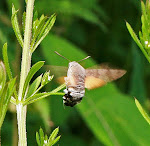.jpg)
June 5, 2010:
At one time there were more than 200 colonies of the Marsh Fritillary in Cumbria but the number subsequently declined quite rapidly. I can recall seeing just a few butterflies at each of three or four surviving colonies in the early 1980s but by 1995 only one colony remained. There, the butterfly lingered on for a few more years but by 2004 it was considered to be on the point of extinction and so drastic action was carried out by the local butterfly Action Group. They took the surviving eggs into captivity and the emerging butterflies were bred on in various ways (in some cases involving strains from other UK localities) with the object of re-introducing the resulting progeny to a few of the old Cumbrian sites. This has now been successfully completed so that at Finglandrigg NNR (near Carlisle) and at a few other sites, the Marsh Fritillary is re-established.
.jpg)
.jpg)
.jpg)
[Perched by a leaf of its food plant, Devil's-bit Scabious]
.jpg)
[Underside view with the light shining through]
The cause of decline is not fully understood but as the butterfly’s specialised habitat became overgrown due to changing agricultural practices, only a few small isolated colonies survived. This resulted in a classic case of population collapse due to inbreeding, the genetic diversity within these small colonies having been lost.
The Finglandrigg site comprises a large marshy pasture lying in a shallow valley bottom where the butterfly’s food plant, Devil’s-bit Scabious (Succisa pratensis), is abundant. In warm sunny weather today, there were dozens of Marsh Fritillaries flying and the whole site must have held hundreds. Small Heaths were also present, again in large numbers.
.jpg)
.jpg)
[The site at Finglandrigg with a lepidopterist photographing a Marsh Fritillary]
This re-established site is an excellent example of what can be achieved by nature conservation. The successful re-introduction of the Lady’s Slipper orchid to south Cumbria is another.
.jpg)
[A Marsh Fritillary with a deformed right hind-wing which had difficulty flying. Could this result from an inherited genetic defect passed down from its small ancestral population?]
.jpg)






No comments:
Post a Comment